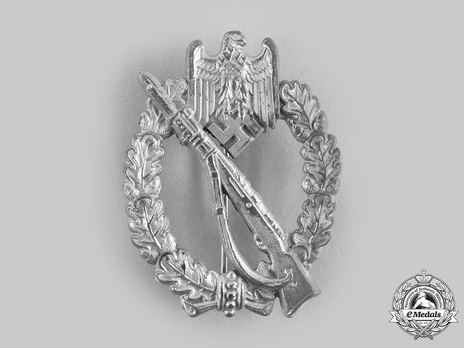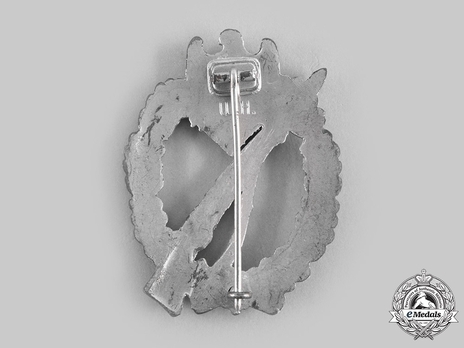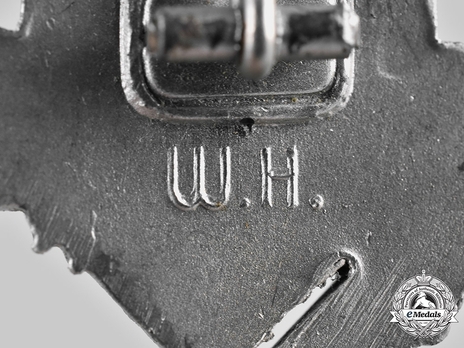Infantry Assault Badge, by W. Hobacher
CATEGORY: Version
SKU: 01.GTR.0602.105.04.000
Estimated market value:



Estimated market value:
Germany, Wehrmacht. An Infantry Assault Badge, Silver Grade, by Wilhelm Hobacher
(Infanterie-Sturmabzeichen in Silber). Constructed of silvered feinzink, the obverse consisting of an oval oak leaf wreath, joined together at the bottom by ribbon, topped by a Heer-style German national eagle clutching a mobile swastika, diagonally across the badge is a Karabiner 98k rifle with the bayonet attached and the carrying sling hanging from the rifle, the reverse with a crimped barrel hinge and vertical pinback meeting a round wire catch, maker marked with the logo of Wilhelm Hobacher, Vienna, measuring 46.75 mm (w) x 61.20 mm (h), weighing 33.0 grams, with some oxidation and loss of finish evident, in overall better than very fine condition.
The Infantry Assault Badge was instituted by Generaloberst von Brauchitsch on December 20, 1939, and was conferred upon infantrymen who demonstrated their bravery and merit in combat. In order to receive the award, an individual had to participate in three or more front line attacks on at least three different days. Counter attacks and reconnaissance counted as an attack.
The Silver Badge was awarded to men of infantry and mountain troop regiments. In special cases, this included ground combat units of the Luftwaffe and Kriegsmarine. Members of the Waffen-SS and police forces were also eligible if they met the prerequisites. It was first awarded in late May of 1940. The Bronze Badge was awarded to men of motorized regiments and was first awarded in early June of 1940.
The badge was originally designed by C.E. Junker in Berlin, but a variety of makers started producing these badges using dies from other makers, or by making their own dies.
The badge can be found in different variations, either hollow die-stamped, semi-hollow die-stamped, or solid die-cast/die forged. The type of hinges and catches used on the badge depend upon the manufacturer. Screwbacks with a circular corrugated patterned plate are very rare.
Some badges were maker marked, others left unmarked, and some carried the company’s LDO number, indicating production for the private retail market.
It is unknown how many Infantry Assault Badges were awarded, but estimates are as high as several million.
Since some companies used very similar designs compared to other local makers, these have been combined in the same design category. There is a large number of makers and variations, which is why not necessarily all versions for every single maker can be shown here.
The Souval design is named after maker Rudolf Souval. However, it is unknown if this particular maker created the design that was used extensively by makers from the greater Vienna area. Many of these makers collaborated with one another. The companies using this design include Rudolf Souval, Friedrich Orth, Grossmann & Co., and Wilhelm Hobacher, as well as one or more additional unknown makers who have yet to be identified.

Comments
Sign in to comment and reply.


Scroll Top